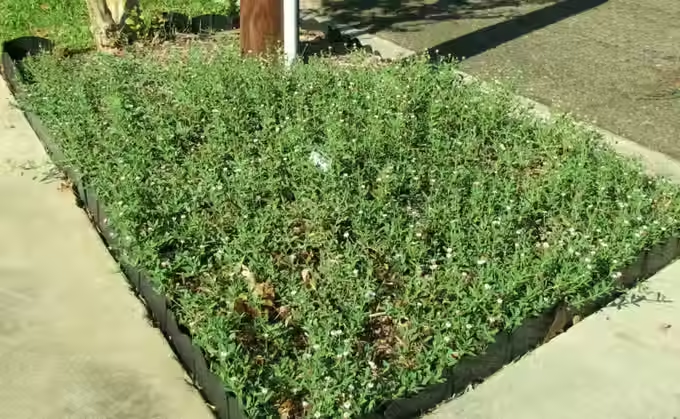We're open for the Season!
Nursery Hours for October-March
Thursday-Saturday: 9:00-5:00 • Wednesday/Sunday: By Appointment
🌲🌲🌲Holiday Schedule🌲🌲🌲
Thanksgiving: Thursday & Friday CLOSED • Saturday OPEN 9:00-5:00
Christmas: 12/23/2025-01/07/2026 CLOSED
Frogfruit
Phyla nodiflora
true
1 gallon
Frogfruit
In stock
6"x3'
Sizes:
Frogfruit – Phyla nodiflora
Also known as: Turkey Tangle Frogfruit, Sawtooth Frogfruit, Common Lippia
Frogfruit (Phyla nodiflora) is a resilient, mat-forming groundcover native to the southern U.S., Mexico, and much of the Americas, including California. It thrives in warm regions and is evergreen in the low desert. With its tough, creeping habit and tiny trumpet-shaped white to lavender flowers, frogfruit is a favorite among pollinators and a practical alternative to traditional turf.
This perennial herb spreads via surface runners and can cover large areas, staying under 6 inches tall. It tolerates foot traffic, adapts to a variety of soil types, and thrives in both sun and part shade. Once established, it requires little water and can endure drought, heat, and occasional flooding. Though once considered potentially invasive in wetter regions, in arid climates like the Colorado and Sonoran Deserts, it behaves as a manageable and highly beneficial plant.
Frogfruit's blooming period stretches from spring through fall, and in the low desert, flowers may persist nearly year-round. It is especially valuable in pollinator gardens, bioswales, and areas where erosion control or living mulch is desired. In containers, between stepping stones, or as a lawn substitute, frogfruit supports both beauty and biodiversity.
A customer once shared they enjoyed watching lizards chase butterflies across their blooming frogfruit groundcover—a perfect image of a thriving desert ecosystem and part of what inspired me to offer it at the nursery.
Wildlife Value
Host Plant: Phaon Crescent (Phyciodes phaon); White Peacock (Anartia jatrophae)
Nectar Source: Confirmed for Monarch (Danaus plexippus); Fiery Skipper (Hylephila phyleus); Painted Lady (Vanessa cardui); White Checkered-Skipper (Burnsius albescens); Reasonable to infer queen butterfly (Danaus gilippus) may also nectar, though not yet verified; various native bees
Bird Resources: Insects; Shelter
Bird Species: Mourning Dove (Zenaida macroura); Lesser Goldfinch (Spinus psaltria); Say’s Phoebe (Sayornis saya)
Note: A sterile hybrid known as Kurapia, developed in Japan, was bred from Phyla nodiflora and is sometimes marketed for similar uses.
Plant Care
Native region:
California; Chihuahuan Desert
Water needs:
Moderate
Exposure:
Full Sun; Partial Sun
Mature size:
6"x3'
Growth rate:
Fast
Flower color:
White
Flower season:
Spring; Summer; Fall
Pruning:
None
Cold Hardiness:
20 Degrees
Nectar-producing:
Yes
Attracts pollinators:
Yes
Nighttime pollinators:
No
Butterflies or Moths:
Yes
Monarchs:
Yes
Larval host:
No
Bees:
Yes
Bats:
No
Birds:
Yes
Nest site:
No
Nest materials:
No
Rabbit-resistant:
No
Tortoises:
No
Growing Plants in the Desert — Important Information
The information presented here is, to the best of my knowledge, accurate and based on reliable research, personal experience in my own garden, observations from other gardens I’ve visited, and time spent studying plants in their native habitats. I always welcome your feedback and experiences to help me continue educating others!
Cacti:
In my experience, cacti are much happier in filtered shade here in the low desert of the Coachella Valley. Their colors are more vibrant and they tend to bloom more profusely, especially the non-native varieties. If you look closely at how our native barrel cactus and beavertail prickly pear grow in the wild, you’ll often find them tucked among rocks or beneath the shelter of creosote and other shrubs.
⚠️ A note of caution: Cacti and succulents are often illegally collected from the wild, which not only damages plant populations but also disturbs entire ecosystems. In some cases, wild populations of cacti have even gone extinct because of this practice. When purchasing these plants, always be sure they’ve been legally obtained. Look for nursery-grown stock or plants with a native plant certification, and keep that documentation for your records.
Light Requirements:
In our desert (Sonoran/Colorado), “full sun” doesn’t always mean what you might think. Many so-called full-sun plants benefit from and actually appreciate some late-afternoon filtered light—especially during the intense summer months.



